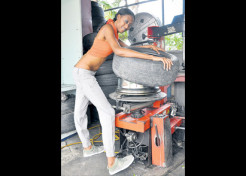
Being careless could leave you car less
HAVING a lot of female friends and being into cars means I get a lot of calls for help when something has already gone wrong.
I never get calls beforehand asking how to check oil or tyres, but once they break down they send out distress calls.
It’s important that women know some basic things about their cars, not so they don’t have to call a man once something is wrong, but so that they can help to maintain their cars and prevent simple things from becoming major problems.
Below are some key tips for making sure you keep your car maintained in between a proper servicing.

The basics
Ladies, it’s not considered cute when you don’t even know where the release is for your bonnet. Take a few seconds to look for it. When you find it, pull the lever. To pop it open there’s usually a latch to pull/slide. Prop your bonnet with the rod.
Once you have done that, make a mental note of everything you just did and close it. Repeat a few times until you’re comfortable. While you have your bonnet open, find your fluid reservoirs — meaning your oil, washer fluid, radiator and transmission fluid. This is important. You will need to know when the levels are low and how and where to add more if necessary.
Because we’re here in Jamaica where it’s warmer, I recommend checking your fluids twice a month. Always keep a small amount of oil, wiper fluid and coolant handy in case your levels are low and you need to add some more.
Bright lights, big problems
This brings me to the lights that come on on your dashboard. Do not ignore them and keep driving. This is your car telling you something is wrong. If your child starts crying would you turn up the music and ignore your child? I didn’t think so. So don’t ignore your car. If the check engine, oil or temperature gauge light comes on, there is more than likely a problem. If you keep driving without having it checked then you are causing damage to your car.
Oil…check!
Checking your oil is not complicated and it’s important. The oil keeps all the moving parts of your car lubricated. Once you know where the reservoir is located (it probably has oil written, or a symbol on it) it’s pretty simple. Most caps will come off with a push down and twist. Next look for the dipstick for your oil. It will probably also have oil written, or an oil drop symbol and most times will have a yellow/orange handle. It will be where your engine is which is towards front of the car. Make sure where you are parked is level and your engine is cool (off for at least 10 minutes). Pull the dipstick out and wipe the end clean with a towel or rag. Put the dipstick back into the pipe, making sure it goes all the way in. Then pull it out. DON’T turn it upside down to look at it, this will make the oil run upward and mess up the reading. A dipstick will have two marks at the end — usually either lines or holes in the stick. You use them to gauge your reading by seeing where the oily part ends and the dry part begins. If it’s between both marks, you’re okay. If it’s below the bottom mark, you’ll need to add a quart of oil. It’s not a good idea to add more than a quart without driving and getting a new reading of your oil level. Also rub a bit of the oil between your fingers. If it leaves a dirty smudge it’s probably time for an oil change. Oil changes are a must.
Tip: It’s normal to lose some fluid between oil changes, but if you find oily marks underneath where you’ve parked your car or you’re adding oil regularly, take it to your mechanic to get it checked. You don’t want your engine to seize up on you — this is the end of your engine and more than likely you’ll need to buy a new one.
Change a tyre — oh the pressure
Your tyres are a critical part of your car. Just like your engine, they need to be properly maintained to guarantee that your car is safe. It is extremely important to make sure they have enough tread on them so they won’t slide when you’re zipping around Mt Rosser or slamming on your brakes as that goat decides to cross the road. Truth is, they also need to be properly inflated.
Having your tyres either over or under inflated can affect the way the car handles on the road. Therefore, you need to check the tyre tread and the pressure often. The details of your tyre can be found on the inside of the driver side door on a strip or in your manual (if you haven’t tricked out your car or made changes).
Tip: Tyre pressure should be checked when the tyres are cold (not driven more than 2km). Unscrew the valve stem cap and press the air pressure gauge. If you hear a hiss it’s not tight enough or the angle you’re using is wrong. If the reading matches your specs then you’re good to go. If not, you will need to add air.
Changing a tyre is an important thing to know — especially for women. Yes, you’re independent but when you get a flat can you change your own tyre? Once you get the hang of it, changing your tyre shouldn’t take more than half an hour.
Everything you need should already be in your car — a jack, tyre iron and a spare are normally found in your trunk. You can’t choose where you get a flat but if you can pull over somewhere safe, with space, and also somewhere that is fairly flat, that will be good.
Be sure to loosen the lug nuts on the tyre before jacking up the car — it makes life much easier. Sometimes you can get a little confused on which direction to turn the nut — left = loose and right = tight. If you have hubcaps that are over your lug nuts, a flat head screwdriver can pop those off but be sure you add that to your trunk in case you get a flat in future. It is important that you practice changing a tyre at home a few times so that should it happen while you’re on the road you’re not struggling.
Learn where to place the jack in order to properly lift the car. Most owners’ manuals will have a description as well as a drawing. If you don’t have a drawing then there is an area called a ‘hard point’ or ‘the lip’ which is located at the underside of the rocker panel located between the two wheel wells. If you’re jacking up the front, look directly under the fender by the front door. There’s a spot where the metal is reinforced and it has a small slot. If you’re jacking the rear, look immediately in front of the rear wheel, under the rear door, or if it’s a two door check the quarter panel.
Once the damaged tyre is off and your spare is on, tighten the lug nuts as much as you can with your fingers and then give them a little turn with the tyre iron. When you’re finished slowly lower the car slowly to the ground. On the ground, use the tyre iron to tighten the lug nuts as much as possible. Do not over tighten the lug nuts.
Tip: If your spare tyre is smaller than your other three tyres, it’s not meant to be driven on permanently. It’s your emergency spare. Do not speed or continue to drive on it for an extended time. Get your tyre repaired and replaced.
Knowing the basics of your car makes you more secure on the road and also more empowered. There’s nothing like a strong and independent woman.



my cousin is 16 and he runs 10.72 in 100 metres
Funnily enough I went a LONG while without knowing how to “pop the hood” of my baby untill life happened – the car just stopped – panic – call breakdown – got told “u need engine oil” eek…lets just say that was the last time that happened as i am now a proper “mechanic” ok exaggerated much but she (yes the car) is now well taken care of…popping the hood n all sorts or bonnet as we call it…lesson learnt!